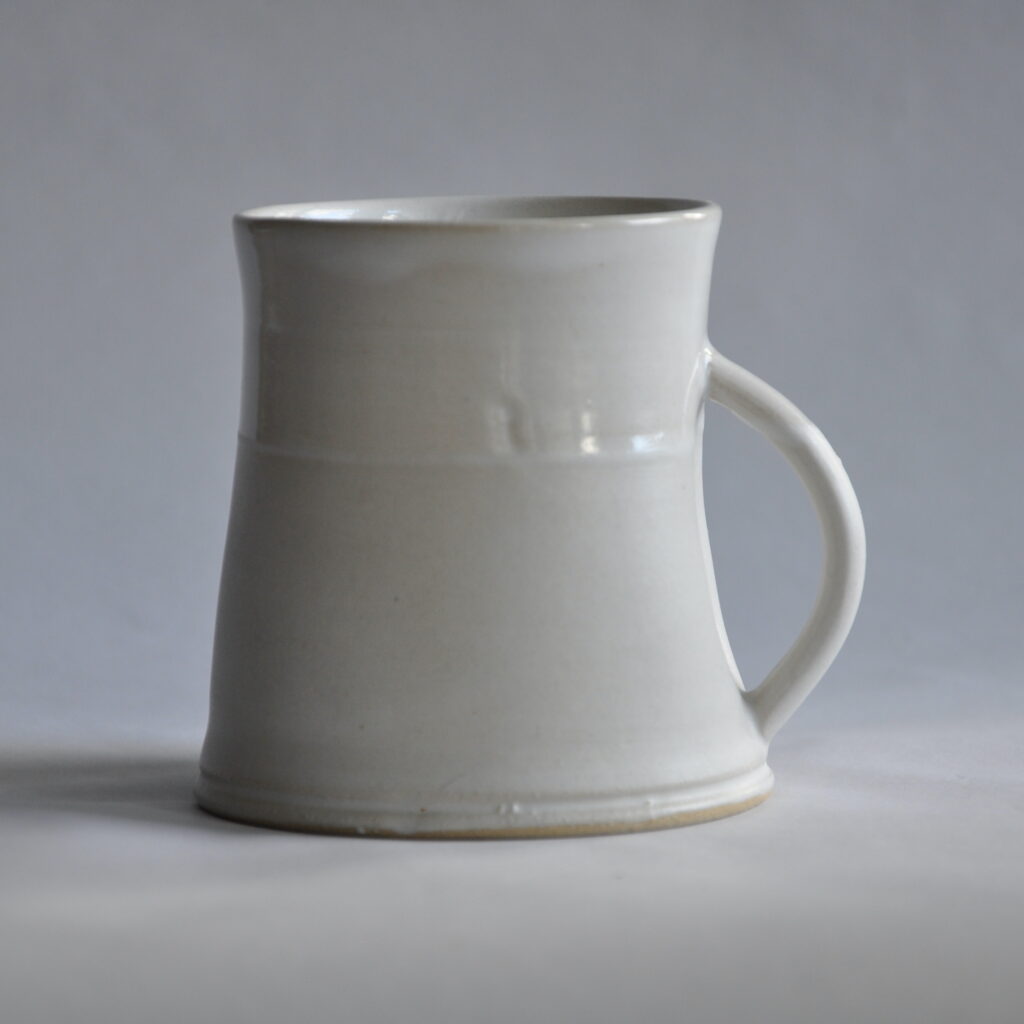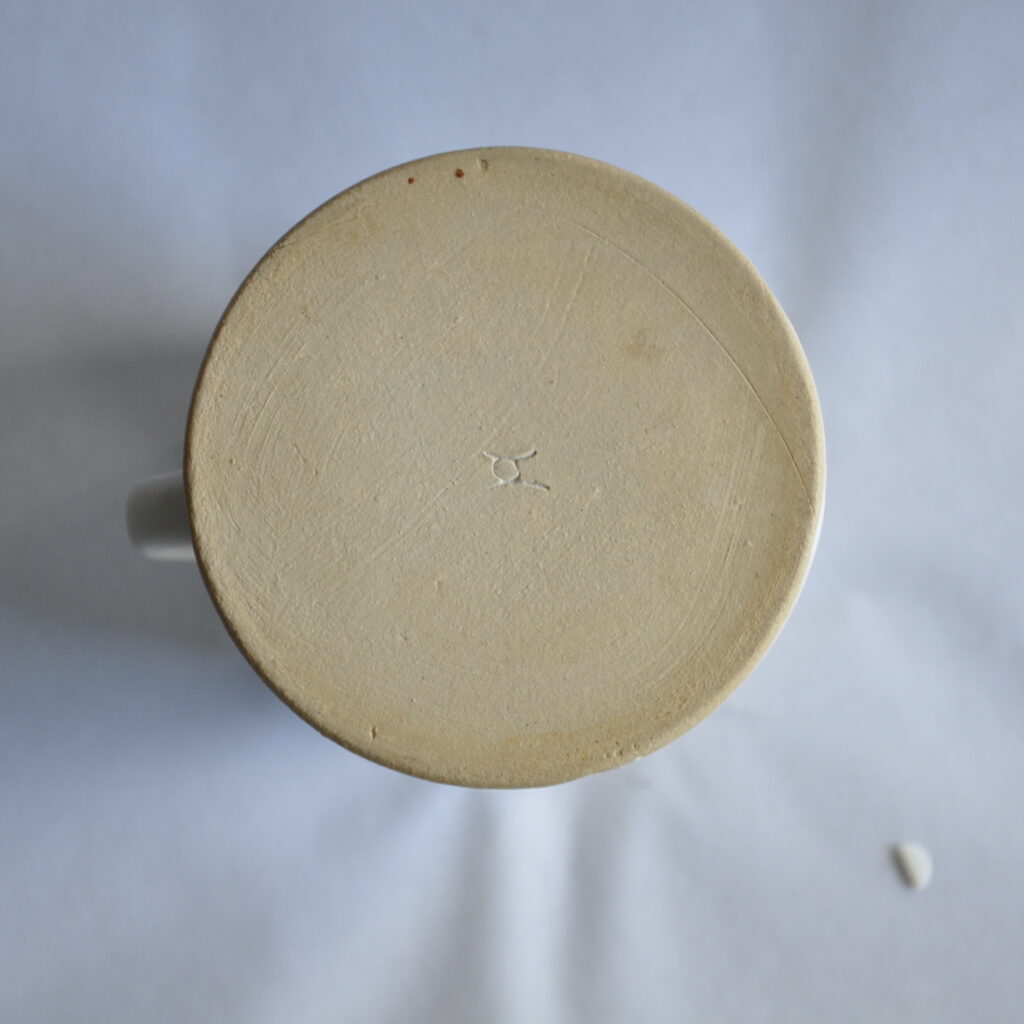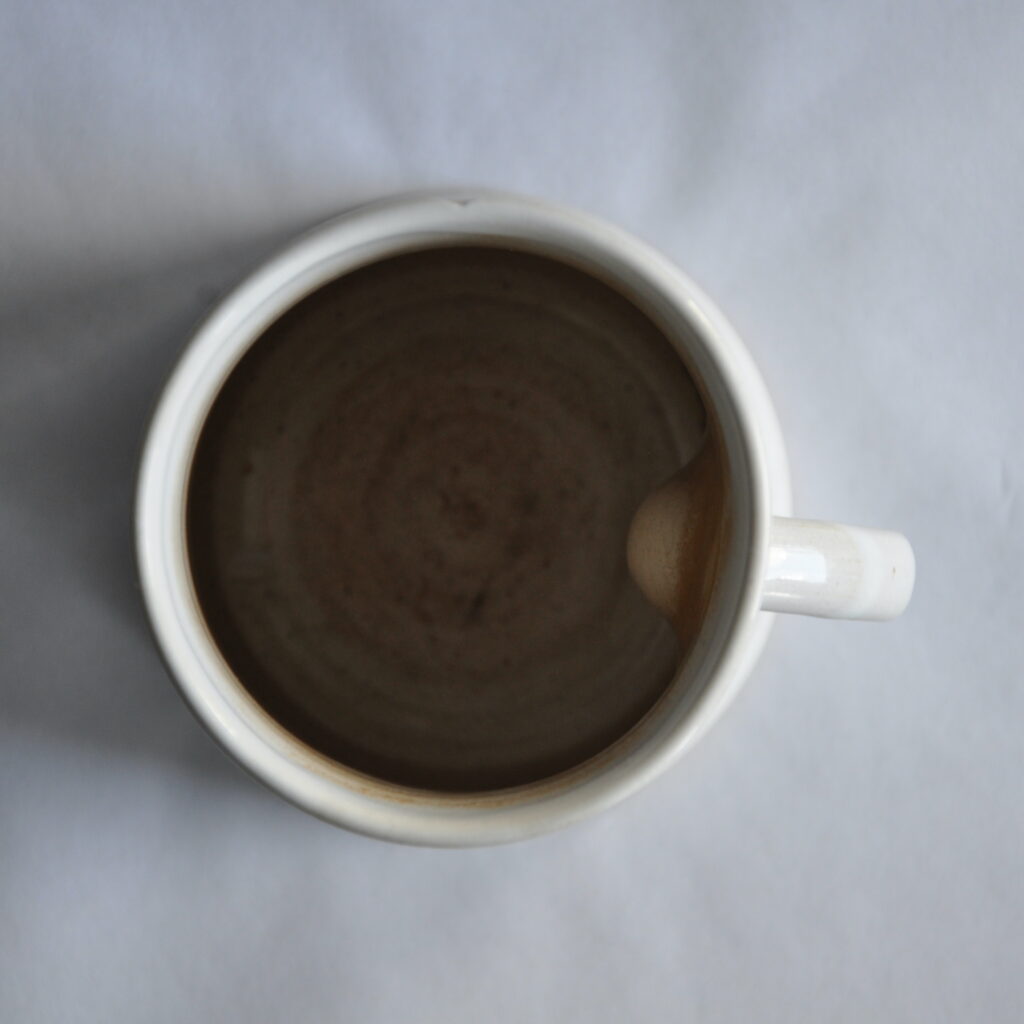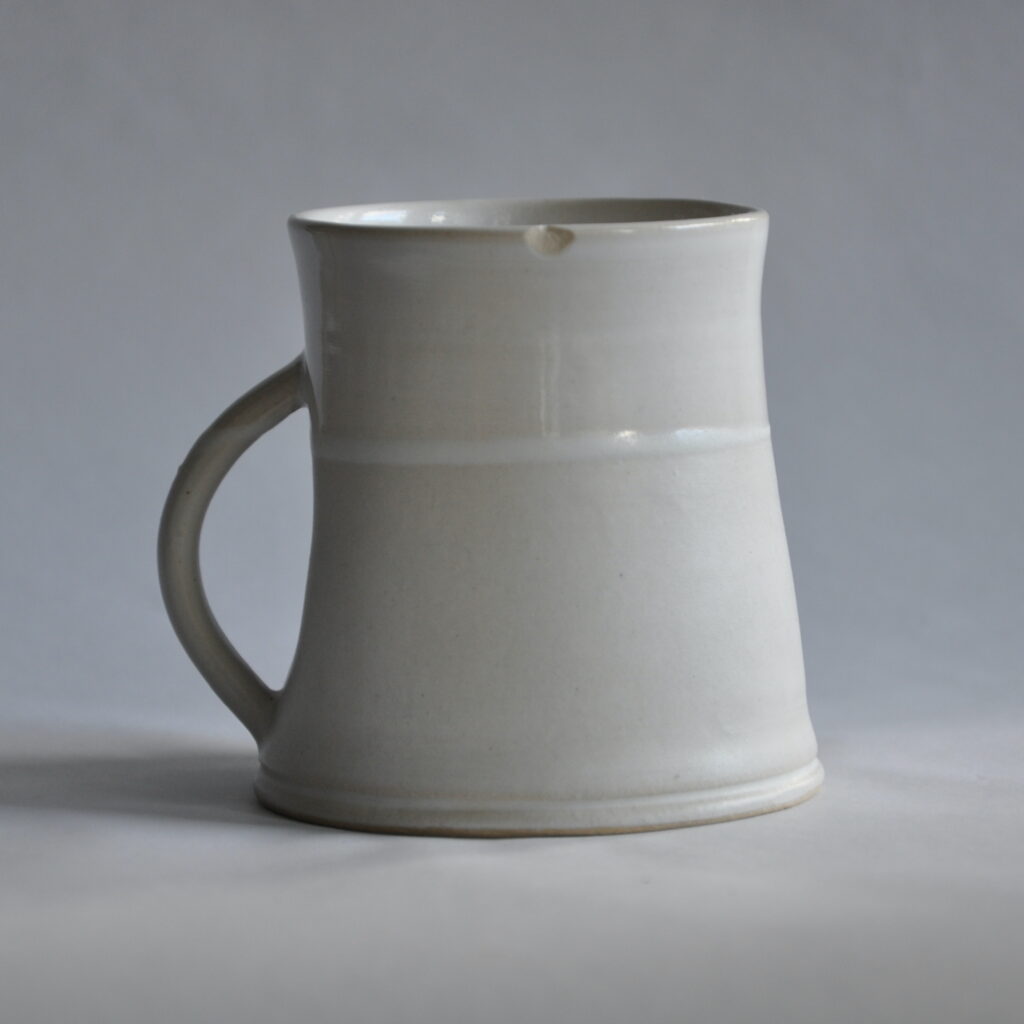TITLE [untitled] ceramic cup
ARTIST/MAKER Pauline Hoerboer
DATE OF MANUFACTURE c. 2017
DATE OF REPORT February 2022
DIMENSIONS H 90 W 100 D 86 mmCURRENT LOCATION Kitchen cupboard above the microwave, second shelf from the bottom, to the left.
KNOWN PROVENANCE Purchased at Kali Tengah, The Hague, 2017.

Figure 1

Figure 2
Description
A small ceramic vessel designed as a drinking cup. Overall,
the cup has a shape reminiscent of a bell with a round base extending up towards a tapered rim. A slender handle is attached to the proper right side (see Figure 1)1 and sits over a vertical indentation roughly the size of a human thumb. On the outer side of the body, a ring has been incised around the diameter forming a slight ridge that juts out just above the base. The base is flat and smooth with slight discolouration at the edges and there are scattered incisions consistent with the appearance of tool marks. A small maker’s mark is apparent at roughly the centre point (see Inscriptions).
The clay is off-white in appearance, which can be observed in unglazed areas, particularly at the base, where it is grainy to touch, porous and stained. It is likely stoneware (see Material Composition). A matte white glaze is apparent on the lower half of the outside of the body. Small pores are apparent on this surface, possibly indicating the presence of air bubbles during manufacture. A glossy white glaze covers the inside of the vessel and extends over the lip and roughly one quarter of the way down the outside of the body, also covering the top of the handle. The glossy glaze has pooled where it meets the matte glaze, as well as around the lip of the vessel forming subtle rings of increased opacity.
Inscriptions
A single maker’s mark at the central point on the base (see Figure 2). The mark measures 9 mm x 6 mm and appears to have been incised with a sharp tool. Although it initially looks like
a rune, or some strange musical notation, the mark is actually
a combination of the maker’s initials placed together so that it reads as a large capital H with a rounded cross bar.
Known provenance, addendum: I have a collection of ‘perfect cups.’ They are invariably handmade ceramic vessels that I find at markets and op-shops and for some reason or another seem perfect. I cannot explain what makes a ‘perfect cup’ beyond a feeling. Buying this cup wasn’t the result of an entirely chance encounter. A couple of days prior my housemate brought home a cup that was almost the same and I coveted it for my collection. Then I saw this one, alone on an otherwise empty shelf at Kali Tengah.
Material Composition
Untested; clay listed as stoneware, glaze not specified.
To bridge the many different definitions of the term ‘clay’ that often correspond to disciplinary boundaries, the American Ceramic Society provides this definition: ‘Clay is a fine-grained rock which, when suitably crushed and pulverised, becomes plastic when wet, leather-hard when dried, and on firing is converted to a permanent rock-like mass.’2 Different clays are often mixed to achieve certain working properties.
The material composition, according to the archaeologist Phillip Stockhammer, can be understood as the substance of a thing, its physical and chemical properties. Although substances initially appear to lack shape, they have microstructures which guide how they might be formed. In turn these properties influence how humans work with the material and how the resulting products might be used.
The plasticity of clay in its wet state is described by chemist Allen A. Denio as ‘a complex phenomenon.’3 In part, it is attributed to the small hexagonal plate crystals that comprise clay’s microstructure, among other things like cation adsorption and the high surface tension of water, properties that have allowed it to be moulded and manipulated for centuries by human hands, and eventually on a wheel.
Conversely, the firing process, through combinations of time and heat, removes the water content of clay and then burns off and inverts component materials, slowly transforming a malleable form into something solid and inert.4 Inert items, especially if glazed, can be used as vessels for food consumption and storage.
Cultural practices of making shape ‘substance’ into ‘materiality.’5
Known provenance, addendum: After weeks of drinking tea from the cup I noticed a similar vessel in the window of a ceramic studio around the corner from my apartment. It was the maker’s studio, and suddenly life in the small network of streets along the canal where I lived seemed tangibly interconnected.
Stockhammer describes three changes that occur when a human encounters an object. In the first moment of the encounter, the human doesn’t change the object but the object changes the human, shifting perceptions of social space and in some cases forcing humans to modify their social practices.6
I thought about the cup and signed up for classes.
Mode of Manufacture (body)
The cup appears handmade, thrown on a wheel. The ridge at the base was likely formed as the body of the vessel was being shaped with a tool that incised and smoothed the area as the clay spun on the wheel. The thumb imprint would have been pressed in once the overall shape of the body was formed; perhaps once it had dried out just a little. The handle would then have been shaped and attached and excess clay smoothed out to form a seamless join.
Hoeboer describes these small indentations, which are often placed under handles on her vessels, as ears.7
When my tea has cooled, I will often hold the cup by
its base in my left hand and rest my right thumb against it. My thumb fits perfectly and I wonder how she managed to create this indentation while leaving the rest of the body so smooth and even.
My memories of her studio: autumn light falling on the canal, quickly walking along cobblestone paths because I was always running late, a scarf wrapped tightly around my neck and chin to keep the cold out; white walls and linoleum floors, the earthy smell of clay and rows of potter’s wheels.
These memories play on a reel akin to a series of flashbacks in a movie. Art historian Ann-Sophie Lehmann writes that still and moving images can capture the complexity and simultaneity of making where words fail. They are visual archives where information and knowledge about making is stored.8

Figure 3

Figure 4
Hands seem to have an enduring focus in the documentation of pottery processes. I scroll through Google images and see square after square of cropped bodies and a wheel with two hands and a lump of clay at the focal point. The clay is in various stages of being shaped and the hands are always covered in a slurry from lightly touching the clay form on the wheel. Although the images are still, I know that the wheel must be moving. But aside from these clues it is difficult to see what occurs beyond various placements of different disembodied hands shaping and making.
‘The hand is about action: it takes, it creates and it could be said that it thinks. When resting, it is not a soulless tool abandoned on a table or hanging down the side of a body. Habit, instinct, and the desire to move are latent within it, and it does not take long to determine the intended action.’9
Lehmann goes on to write that images, both moving and still, fragment and compress. In showing one thing, they leave out another and can easily be used to mystify or obscure creative processes.10 My memory feels like this too.
I re-watch the memory-cum-movie of the studio in my head: hands, my own, shaping spinning lumps of clay, the lumps wobbling, pushing themselves out of alignment, while in another frame, another more experienced set of hands demonstrates the same process so easily. The ridge at the base might have been made with an old credit card – there is a pile of them covered in slurried finger marks – one of the edges held flush against the spinning wheel as a small cut out at the corner of the card incised an even line roughly half a centimetre from the base. Although what I learnt in a handful of lessons at her studio over five years ago now is murky and fading out of focus.
Known provenance, addendum: For months after purchase, when not in use the cup was stored in an open nook in a kitchen. One with mint green walls and brown tiled counters. It was kept with a collection of other mismatched cups, mostly second hand and collected by my housemate in the decade since she had left home. Invariably though, it would sit next to an almost identical cup by the same maker, bought by my housemate from the same shop a couple of days before I bought mine, differentiated only by a slight difference in height and a fingernail imprint where the glossy and matte glazes meet (see Figure 1).
Mode of Manufacture (surface)
A thin glass layer or glaze is applied to a ceramic vessel during the firing process which functions as both utilitarian and aesthetic.
‘I glaze my work by dipping it. One side in glossy white, the other in matte white. Dipping is a very direct technique. You can see the line between gloss and matte. Its honesty appeals to me, it has a very accessible logic to it.’11
Known provenance, addendum: The cup moved with me when I came back to Australia, packed in my hand luggage, wrapped in a scarf. I expected it to break, but it didn’t.
Condition
The cup is in generally good condition, however displays signs of use. On the inside surface there is brown staining that forms a fuzzy patina, layers of built-up tannins from daily cups of tea (see Figure 3). Art historian Barbara Baert writes that each stain is a history evoking time, memory and place.12 Stains extend our physical boundaries, recording our dealings with the world in the form of amorphous marks on the things in our orbit. The tea stains sit on the surface of the ceramic glaze, they have not seeped in. This I know, because I have scrubbed them off before with a coarse sponge and copious amounts of detergent. My attempt to remove them was imperfect and uneven, leaving patches of tannin under the thumb indentation and the tight curve where the body and base meet. After doing this, I immediately felt as though I had scrubbed away a small part of my past and resolved to let the staining build up again.
Stockhammer’s second changeability pertains to intrinsic changes that occur within an object, the natural process of ageing ostensibly free from human involvement. The third changeability is caused by external, often human, actors. These changes, although rooted in the physical change of the object, transform how we interact with them. Traces of use are witnesses of the past, anchoring memories, connecting past and present.13
I want to classify the tannin staining as a second changeability but this is not correct. As far as I can tell, there have been no inherent changes caused to the substance of this cup since it was fired at least five years ago. It remains inert and stable, simply bearing traces of my actions, my tastes and carelessness.
On the backside of the rim, just slightly to the left, there is a small chip (see Figure 4). The chip is shallow, measuring 6 mm x 4 mm and at its edges, if you look closely, you can see a cross-section of materials, porcelain and glaze bordering a faint, dark line where the top layer of glossy glaze is gone and a more matte version peeks through.
I remember: Carrying my cup up and down the stairs of my Sydney sharehouse, between my bedroom and the kitchen, I always made sure not to trip as I imagined shattered ceramic shards at the bottom of the stairs.
I remember: Over a decade ago, living in a Melbourne sharehouse where it was so cold in winter that one morning two glasses shattered when I poured boiling water into them, one after the other.
I remember: Slipping on the worn floorboards in the apartment in The Hague and spilling scalding tea over my thumb as I held stubbornly onto my cup, and the soft blister that formed not long after.
And then: A mild winter morning in the same Sydney sharehouse, washing my cup and placing it rim down on the sink, the clink of ceramic on glass and a chip from my perfect cup sitting on the kitchen counter.
Known provenance, addendum: I haven’t used this cup since chipping the lip, although I haven’t ruled out the possibility that I one day might. For now, it sits in my kitchen cupboard, a small reminder of a brief period in two different cities where I no longer live. Sometimes in the late afternoon, when the sun is out, I will open the cupboard and look at it there. Shadows are cast over it, light reflects on the glossy upper glaze. Shifting and moving as the tree outside shivers in the breeze.
Johanna Ellersdorfer is a writer, researcher and paintings conservator. She is currently completing a PhD at the University of Sydney working at the intersection of material culture studies, art history and creative writing.
Pauline Hoeboer Keramiek, https://www.paulinehoeboer.nl/en/
